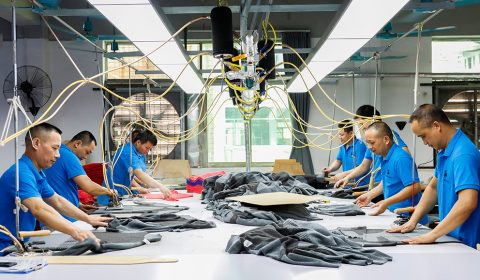Seasons are not only a symbol of temperature and weather, but also the driving force of the fashion industry. Around the world, seasonal changes have led to consumers’ desire for new styles, so brands and designers must constantly come up with new ideas to cater to the ever-changing market. The concept of seasonality affects the entire supply chain, from design, production to sales, and needs to make corresponding adjustments according to seasonal changes.
Seasons are seen in the clothing industry as a source of inspiration and a driver of market demand. Each season gives clothing a specific functional and aesthetic character, prompting designers to create unique styles that are in keeping with the season. From light spring and summer clothes to heavy autumn and winter pieces, seasonal design makes the clothing industry full of change and vitality.
Spring clothing trends
Spring is the time of year when temperatures gradually warm up and the earth comes back to life. The cold winter is gradually passing, and the breath of spring is full of new life and vitality. The warm sun shines on the earth, the breeze blows gently, and the flowers bloom. The climate of spring is usually warm and variable, from fresh and cool in the morning to warm during the day to slightly cool at night.
In such a climate, spring clothing needs to take into account the characteristics of large temperature differences. Light and breathable fabrics become the mainstay to adapt to the warm sunshine during the day and the slightly cool temperature changes at night. Soft colors, such as light blue, fresh green, pink, etc., can be integrated with the natural scenery of spring, bringing fresh and comfortable feeling to the wearer.
The major trends in spring fashion design reflect the fashion industry’s sensitivity to seasonal demands. In design, light texture and loose cut become the main elements of spring clothing. Pay attention to design details, such as folds, lace, hollow, etc., to add layers and design sense of clothing. In addition, a variety of styles, including skirts, shorts, short jackets, etc., meet the consumer’s diverse dress needs in the spring.
Collections launched by well-known brands in spring often set the trend and inject new vitality into the fashion industry. For example, a brand’s spring collection may highlight lightweight fabrics such as cotton, silk, linen, etc., to create clothing that is extremely comfortable. In terms of design, large-area flower patterns or unique embroidery techniques may be added to show the unique style of the brand.
Summer clothing demand
Summer is the time of year when temperatures rise, usually accompanied by high temperatures, humidity and sunny weather. This season presents a unique demand for clothing, and people are looking for comfortable, cool and breathable wearing experiences. In the hot summer, people are more willing to choose light and cool clothing to maintain comfort. In addition, UV radiation also increases, so sun protection becomes an important consideration in summer clothing design.
Summer clothing design has unique characteristics in lightness, breathability and fashion. The choice of fabric becomes crucial, and natural fibers such as cotton, linen, and silk become preferred because of their good breathability and hygroscopic properties. The pursuit of simple and lightweight design, focusing on cutting and pattern, to ensure that the wearer can be comfortable in high temperatures. In terms of color, fresh and bright colors are more easily welcomed and can reflect the relaxed and pleasant atmosphere of summer.
Summer is not only the season of high temperatures, but also the season of vacations and all kinds of fashion activities. Fashion brands usually launch new models in the summer to meet the eager demand for fashion. The holiday season drives demand for holiday-style clothing, such as beach dresses, swimsuits and lightweight vacation suits. Fashion events such as Summer fashion Week also influence the design trend of summer clothing and lead the development of fashion trends.
In summer clothing design, designers need to cleverly balance fashion and functionality to meet the diverse needs of people in the high temperature season. Breathability, coolness and fashion become the key design elements of summer clothing.
Fall Fashion trends
Autumn is the transition period from summer to winter, the temperature gradually becomes cooler, and the temperature difference between day and night gradually increases. This change requires clothing to provide adequate warmth even when the temperature difference between morning and night is large. Autumn is usually accompanied by changeable weather, from sunny to cloudy to showers, so clothing design needs to take these meteorological changes into account.
Autumn clothing tones are often deep, warm colors, such as dark brown, dark red, olive green, reflecting the scenery of leaf change in nature. Designers love to use these colors to create a warm fall look.
In the fall, common fabric choices include wool, cloth, velvet, etc., which provide enough warmth and comfort. Wool coats, cloth coats become the classic choice for autumn, they not only have good thermal performance, but also show a noble and elegant atmosphere.
Due to the changeable autumn weather, the layered overlay became the focus of the design. Sweaters with vests, scarves, long coats, etc., can not only keep warm, but also create a stylish look.
Winter Clothing Challenge
The climate in winter is often cold and changeable. The temperature drops sharply and the weather can become dry, even with snow, rain, or cold winds. These harsh weather conditions pose a serious challenge to clothing, as clothing not only needs to provide adequate warmth, but also needs to be waterproof, windproof and other functions. In such an extreme climate, designers need to think about how to keep clothes fashionable and comfortable while maintaining warmth.
The design needs of winter clothing are not limited to warmth, but also need to consider a variety of elements. First of all, the choice of fabric becomes particularly critical, and it is necessary to choose materials with good heat retention and strong air permeability to ensure that the wearer can stay comfortable in a cold environment. Secondly, the design needs to take into account a variety of wearing scenes, including outdoor activities, office, social, etc., so the fashion design must have diversity and practicality. At the same time, the choice of color and pattern should also fit in with the winter atmosphere, bringing people a sense of warmth while losing a sense of fashion.
In winter clothing design, the balance between warmth and fashion is a key task. The warmth is not only reflected in the selection of fabrics, but also in the cut of the design, the thickness, and the use of accessories. At the same time, the pursuit of fashion also needs to take into account practicality, ensuring that fashion elements do not hinder the thermal effect. How to integrate creative design into functionality is an important consideration in winter clothing design, such as detachable fur collar, multi-layer design, and detail-oriented decoration, etc., are effective means to achieve this balance.
Seasonality has a profound impact on the clothing industry, not only changes in temperature and climate, but also an important driving force for the continuous evolution of the fashion industry. Each season presents a unique atmosphere, providing a rich space for inspiration and creativity in fashion design. Spring focuses on fresh, summer emphasizes cool, autumn pursues warmth, winter ushered in the demand for warmth, this diversity not only meets the actual needs of consumers, but also promotes the continuous innovation of the fashion industry. From short sleeves to down jackets, from beach dresses to sweater coats, the clothing industry shows off endless design possibilities in seasonal changes.
Seasonality also has a significant impact on apparel retail. Retailers need to prepare seasonal inventory in advance to accommodate demand peaks in different seasons. The promotion of seasonal goods has also become an effective means to attract consumers. Overall, flexible response to seasonal demand has become one of the key factors for the success of clothing brands.




 English
English Deutsch
Deutsch Français
Français Italiano
Italiano Español
Español Русский
Русский Polski
Polski Nederlands
Nederlands Svenska
Svenska
